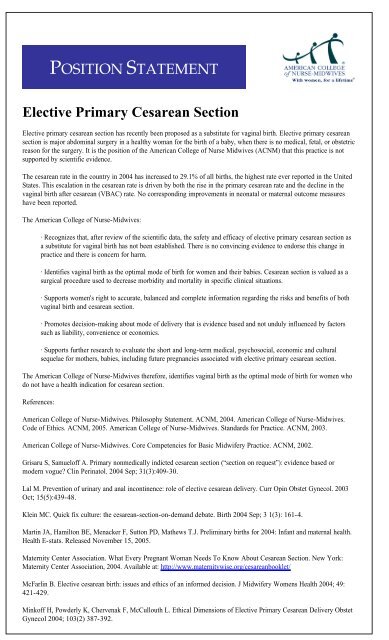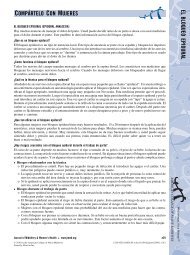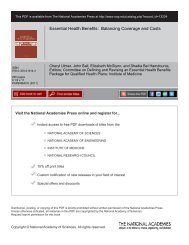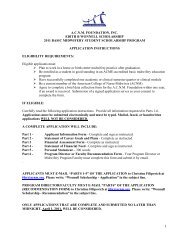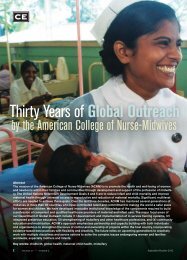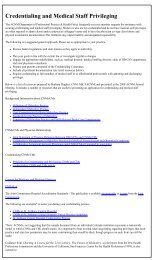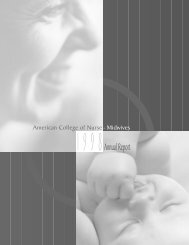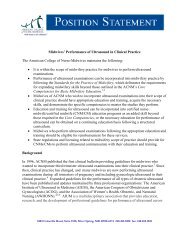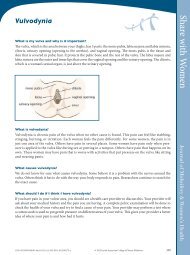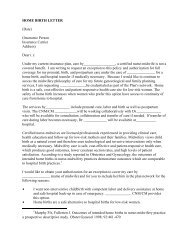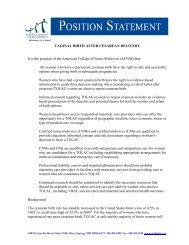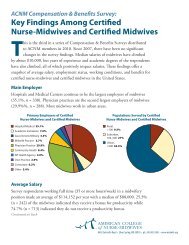Elective Primary Cesarean Section POSITION STATEMENT
Elective Primary Cesarean Section POSITION STATEMENT
Elective Primary Cesarean Section POSITION STATEMENT
You also want an ePaper? Increase the reach of your titles
YUMPU automatically turns print PDFs into web optimized ePapers that Google loves.
<strong>POSITION</strong> <strong>STATEMENT</strong><br />
<strong>Elective</strong> <strong>Primary</strong> <strong>Cesarean</strong> <strong>Section</strong><br />
<strong>Elective</strong> primary cesarean section has recently been proposed as a substitute for vaginal birth. <strong>Elective</strong> primary cesarean<br />
section is major abdominal surgery in a healthy woman for the birth of a baby, when there is no medical, fetal, or obstetric<br />
reason for the surgery. It is the position of the American College of Nurse Midwives (ACNM) that this practice is not<br />
supported by scientific evidence.<br />
The cesarean rate in the country in 2004 has increased to 29.1% of all births, the highest rate ever reported in the United<br />
States. This escalation in the cesarean rate is driven by both the rise in the primary cesarean rate and the decline in the<br />
vaginal birth after cesarean (VBAC) rate. No corresponding improvements in neonatal or maternal outcome measures<br />
have been reported.<br />
The American College of Nurse-Midwives:<br />
· Recognizes that, after review of the scientific data, the safety and efficacy of elective primary cesarean section as<br />
a substitute for vaginal birth has not been established. There is no convincing evidence to endorse this change in<br />
practice and there is concern for harm.<br />
· Identifies vaginal birth as the optimal mode of birth for women and their babies. <strong>Cesarean</strong> section is valued as a<br />
surgical procedure used to decrease morbidity and mortality in specific clinical situations.<br />
· Supports women's right to accurate, balanced and complete information regarding the risks and benefits of both<br />
vaginal birth and cesarean section.<br />
· Promotes decision-making about mode of delivery that is evidence based and not unduly influenced by factors<br />
such as liability, convenience or economics.<br />
· Supports further research to evaluate the short and long-term medical, psychosocial, economic and cultural<br />
sequelae for mothers, babies, including future pregnancies associated with elective primary cesarean section.<br />
The American College of Nurse-Midwives therefore, identifies vaginal birth as the optimal mode of birth for women who<br />
do not have a health indication for cesarean section.<br />
References:<br />
American College of Nurse-Midwives. Philosophy Statement. ACNM, 2004. American College of Nurse-Midwives.<br />
Code of Ethics. ACNM, 2005. American College of Nurse-Midwives. Standards for Practice. ACNM, 2003.<br />
American College of Nurse-Midwives. Core Competencies for Basic Midwifery Practice. ACNM, 2002.<br />
Grisaru S, Samueloff A. <strong>Primary</strong> nonmedically indicted cesarean section (“section on request”): evidence based or<br />
modern vogue? Clin Perinatol. 2004 Sep; 31(3):409-30.<br />
Lal M. Prevention of urinary and anal incontinence: role of elective cesarean delivery. Curr Opin Obstet Gynecol. 2003<br />
Oct; 15(5):439-48.<br />
Klein MC. Quick fix culture: the cesarean-section-on-demand debate. Birth 2004 Sep; 3 1(3): 161-4.<br />
Martin JA, Hamilton BE, Menacker F, Sutton PD, Mathews T.J. Preliminary births for 2004: Infant and maternal health.<br />
Health E-stats. Released November 15, 2005.<br />
Maternity Center Association. What Every Pregnant Woman Needs To Know About <strong>Cesarean</strong> <strong>Section</strong>. New York:<br />
Maternity Center Association, 2004. Available at: http://www.maternitywise.org/cesareanbooklet/<br />
McFarlin B. <strong>Elective</strong> cesarean birth: issues and ethics of an informed decision. J Midwifery Womens Health 2004; 49:<br />
421-429.<br />
Minkoff H, Powderly K, Chervenak F, McCullouth L. Ethical Dimensions of <strong>Elective</strong> <strong>Primary</strong> <strong>Cesarean</strong> Delivery Obstet<br />
Gynecol 2004; 103(2) 387-392.
Minkoff H, Chervenak F. <strong>Elective</strong> <strong>Primary</strong> <strong>Cesarean</strong> Delivery. New England Journal of Medicine 2003; 348(10): 946-<br />
950.<br />
National Collaborating Centre for Women’s and Children’s Health [U.K.]. Caesarean section. Commissioned by the<br />
National Institute for Clinical Excellence. London: RCOG Press, April 2004.<br />
Wax JR, Cartin A, Pinette MG, Blackstone J. Patient choice cesarean: an evidence-based review. Obstet Gynecol Surv.,<br />
2004 Aug; 59 (8):601-16.<br />
* Midwifery as used throughout this document refers to the education and practice of certified nurse-midwives (CNMs)<br />
and certified midwives (CMs) who have been certified by the American College of Nurse-Midwives (ACNM) or the<br />
American Midwifery Certification Board, Inc. (AMCB), formerly the American College of Nurse Midwives Certification<br />
Council, Inc. (ACC).<br />
Source: Board of Directors<br />
Approved by the ACNM Board of Directors: December 2005<br />
8403 Colesville Rd, Suite 1550, Silver Spring MD 20910 240-485-1800 Fax: 240-485-1818 Web: www.midwife.org


